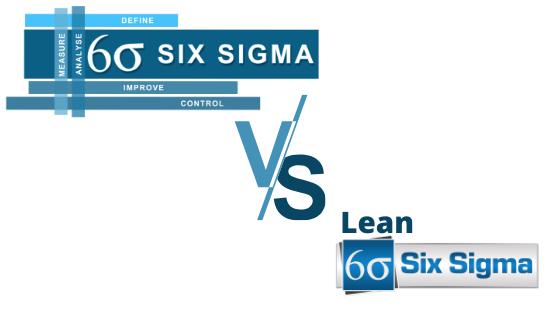Have you come across the term Six Sigma certification vs Lean Six Sigma recently? There has been a long term debate in the business world on what is better: Six Sigma or Lean Six Sigma.
Many people hold a strong conviction about which method is the best way to reduce costs and eliminate waste. Lean production is a systematic way for waste elimination and flow creation, while Six Sigma is a set of techniques that aim to significantly reduce the defect rate.
Six Sigma certification vs Lean Six Sigma: Which is better for Career
Both parties have proponents and detractors who can cite different situations where one system can produce better results than the other.
Some claim that both Six Sigma and Lean concepts must be integrated as the best method for building the most productive and secure business structure. In the context of the debate, however, the differences and similarities between the two systems must be understood.
Main Objective of Six Sigma
Six Sigma's primary goal, through streamlining and improving all business processes, is to remove defects and waste, improving quality and effectiveness. During its first manufacturing design, practitioners quickly found that Six Sigma can be of use and applicable in every aspect of company-from customer support to service delivery.
Six Sigma currently plays a major part in corporate leadership and its extensive application will help a company produce outcomes that are true and tangible.
Main Objective of Lean and Lean Six Sigma
Lean is used by organizations to boost production and manufacturing processes. Lean's main focus is to cut unnecessary and wasteful steps in the creation of a product in such a way that steps are taken that add value directly to the product.
One way to determine whether anything has value is to consider whether or not a customer is willing to pay for it as far as lean methodology is concerned. Any input that does not add value is simply eliminated from the equation and a highly sophisticated and profitable method is developed that is smooth and effective.
Six Sigma and Lean systems have the same purpose. Both strive for waste elimination and the best possible system, but they take different approaches in order to achieve this objective. The main thing about Six Sigma Certification vs Lean Six Sigma is that they differently identify the root cause of waste.
Lean practitioners agree that waste originates from unnecessary manufacturing steps that don't add value to the finished product, whereas Six Sigma advocates argue that the waste comes from improvements in the process. Naturally, in both these assessments, there is a fact, which is why the methodologies of Six Sigma and Lean Six Sigma are successful in improving business performance in different areas. Both disciplines have demonstrated particular success in collaborating, which is why Lean Six Sigma has been developed.
Six Sigma Certification vs Lean Six Sigma
When we compare Lean Six Sigma versus Six Sigma, they all work for the same ultimate aim: waste management and efficient processes. They just take different approaches to how to do this.
Lean focuses on process optimization for cycle time reduction and waste elimination. Lean is dedicated to increasing consumer satisfaction by using a few resources. Six Sigma is committed to almost flawless performance, rising costs, and increasing customer loyalty. In order to sum up the main difference between Lean and Six Sigma, Six Sigma focuses on ways of increasing flow.
Every company has areas that need to be improved, and it is sometimes difficult to know where to begin. And as the Six Sigma Certification vs Lean Six Sigma debate in the business world continues, you might not know whether or not your company has been following the right method.
One similarity between Lean and Six Sigma was the fact that the quality of your product and customer experience can be dramatically improved by improving processes. As the article states, in order to improve inefficient processes, most companies feel that they have only to choose one way in the future.
Choosing the right certification
No single body offers the six sigma certification and it is subject to the guidelines of the organization which varies accordingly. There is also some confusion about the six sigma certification level.
One can obtain the comprehensive training in Six Sigma and Lean Six Sigma from one single source along with the six sigma online course and the Lean Six Sigma certification program through proper channel.
Lean Six Sigma and Six Sigma – Do they coexist in any organization?
The usage and coexistence of six sigma methods will precede lean strategies. In several simple procedures, Lean provides flexibility and repeatability. Once stability is achieved, much of the variation from human processes disappear. The data gathered to support six Sigma operations are therefore much more precise and reliable.
The major business problems do fall in the below categories:
- The need for minimizing the redundancies and inventories
- The need for improving the workflows
- The need for speeding up the process
- Also, there are some human mistakes
If yes, then lean six sigma tools must be utilized for:
Simplifying the process
If the process is more complex, a fully skilled task force would be required in order to carry out these processes. As much as possible, processes should, therefore, be simplified and Lean tools may be used.
1. Increasing the speed
For the consumer, speed is indeed a significant factor. The speed component has a direct relationship with customer satisfaction when improved.
2. Improving the flow
Lean tools should be used to improve the flows of our processes as far as possible.
3. Minimizing the inventories
Critical aspects of a certain process are inventories. Larger stocks contribute to higher land prices, as well as wear and tear of raw materials and much more. Similarly, smaller inventory levels lead to a stop in production because raw materials are not available when necessary.
More and more companies (manufacture, service, hospitals, municipalities, army, and insurance) have joined forces in a lean six-sigma approach. The combinations vary widely in their mechanisms. Management guidance and participation, a trained team of specialists, the use of teamwork, project management, team members' training, the humane treatment of people, a clear problem-solving methodology, and a mechanism of application of appropriate tools are among the most effective approaches.
Concluding Thoughts
We frequently hear the exciting transformations that the businesses see with the help of Lean or Six Sigma have seen. The truth is, however, that most enterprises that accept either fail. Sixty percent of all the Six Sigma programs are unsuccessful and 40 to 60% of the lean projects do not get the results. Why does this happen?
Whenever a new project is begun in Lean or Six Sigma, the initial momentum and excitement are always there. However, over time, most enterprises cannot simply support changes and often return to the previous inefficient processes they had when they began.












No Comments